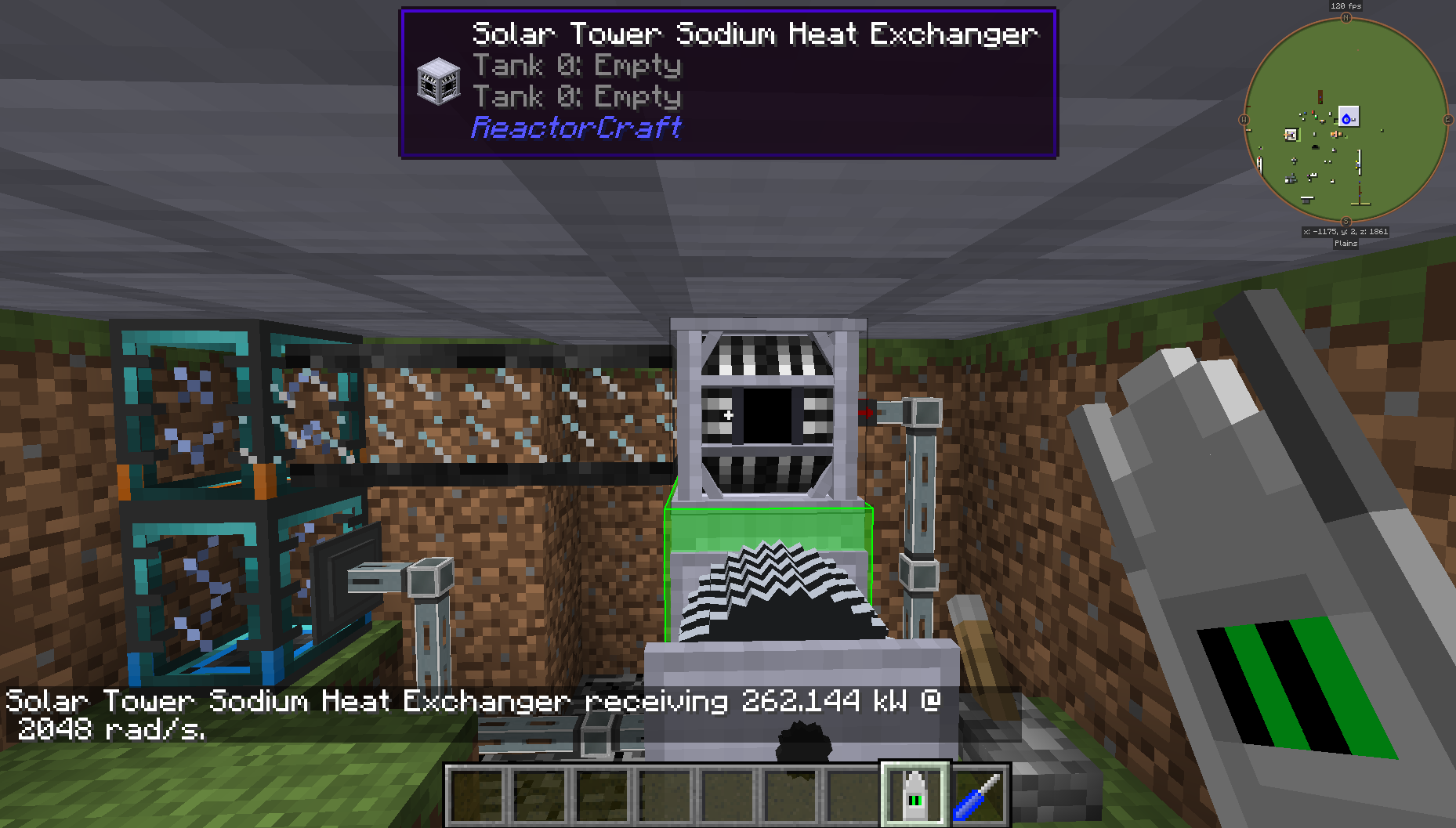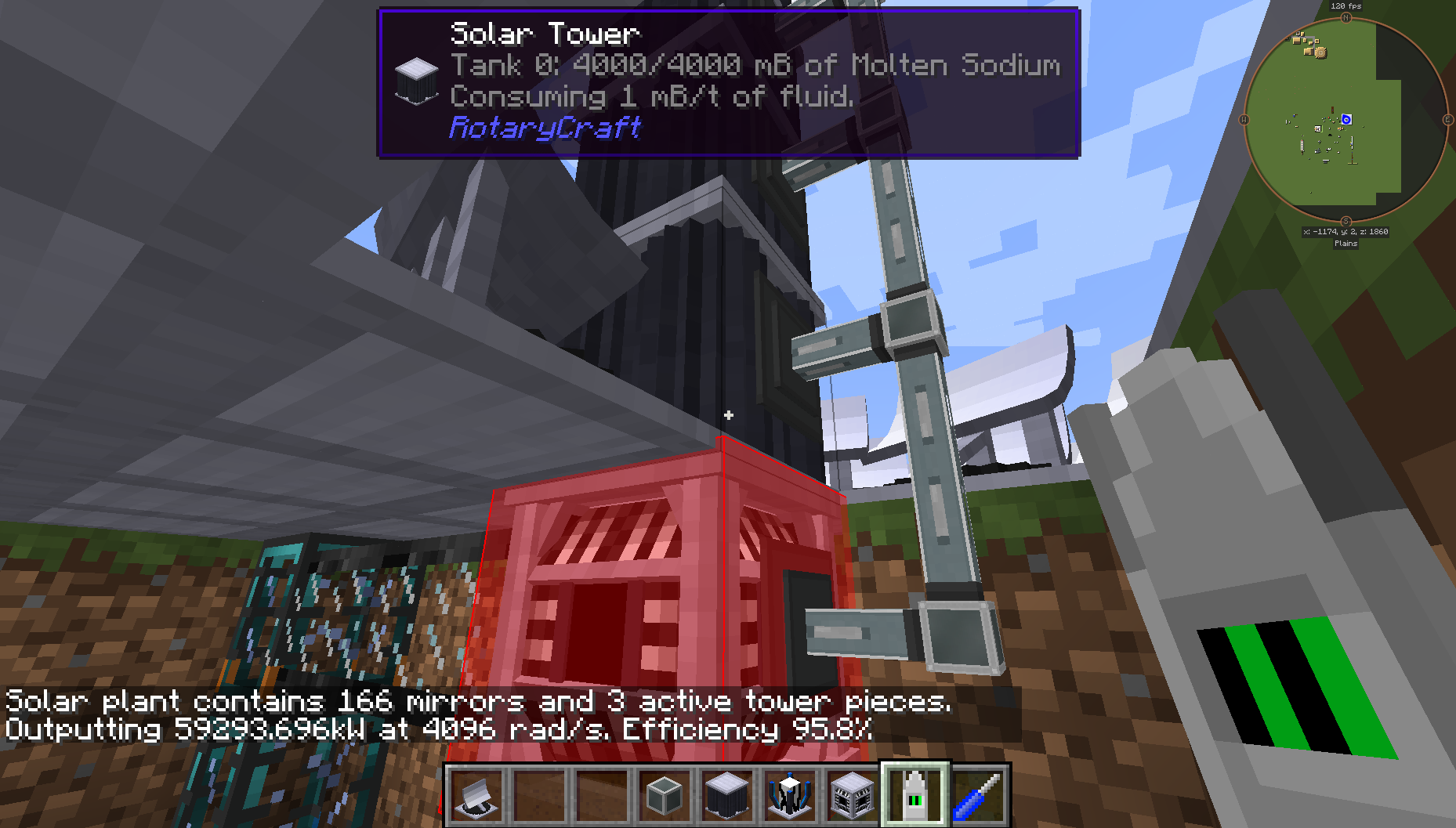Changing it too much could severely damage how realistic the processes are, and by extension, that of the mod. This is - obviously - extremely undesirable. Also, you already CAN turn forge ingotSteel into HSLA natively.What are Reika's opinions on adding new (more expensive) recipes for simple Rotarycraft and Chromaticraft items, such as HSLA steel or crystallized stone? I was thinking of adding an "HSLA catalyst", made from gunpowder, sand, and coal coke, that can be used with regular steel in an alloy smelter to make HSLA steel, as well as a fluid transposer method of turning one obsidian and one crystal fragment worth of molten potion crystal into crystallized stone.
These would be simpler methods of getting these base items, yet more expensive, giving players easy access to basic machines, but encouraging them to look into the regular, more efficient ways of doing things. I'm thinking of doing something like IE:E, just with some lesser-used mods, and would like to center progression around the Reika mod suite.
Mod Feedback [By Request] RotaryCraft Suggestions
- Thread starter Reika
- Start date
-
The FTB Forum is now read-only, and is here as an archive. To participate in our community discussions, please join our Discord! https://ftb.team/discord
You are using an out of date browser. It may not display this or other websites correctly.
You should upgrade or use an alternative browser.
You should upgrade or use an alternative browser.
Yes, it's a modpack thing. I'm designing a pack that will hopefully be used by a server full of players that are new to RoC and ChC. These additions, not changes, would be an easier starting point for those players.
Hmm... I forgot about the steel purifier. Maybe 1 iron and 1 HSLA catalyst, plus a significant amount of RF, can make 1 HSLA steel. Again, this is meant to be a more expensive recipe, but easier for new players.
I was also considering adding in creative-mode items gated behind end-game ChC instead of Avarita. Like I said, it's in the vein of IE:E.
Hmm... I forgot about the steel purifier. Maybe 1 iron and 1 HSLA catalyst, plus a significant amount of RF, can make 1 HSLA steel. Again, this is meant to be a more expensive recipe, but easier for new players.
I was also considering adding in creative-mode items gated behind end-game ChC instead of Avarita. Like I said, it's in the vein of IE:E.
That kind of thing you're less likely to be able to do, it's not like HSLA is hard to get, and adding an easy alternative kind of goes against the whole point. It just disadvantages the people who use it, costing more resources and leaving them worse off when heading into the rest of the mod anyway, and adding a recipe for HSLA that's easier for people not using RotaryCraft is stupid, because if they're not using RotaryCraft they shouldn't be using HSLA.Hmm... I forgot about the steel purifier. Maybe 1 iron and 1 HSLA catalyst, plus a significant amount of RF, can make 1 HSLA steel. Again, this is meant to be a more expensive recipe, but easier for new players.
Changing to a more complex and realistic process for HSLA could work, I've seen a pack that does it as mentioned, but adding an easy alternative for something like HSLA seems like poor design on multiple levels.
Are they creative items from other mods? You'll probably be fine. If they're creative items from RotaryCraft or ChC I have strong doubts.I was also considering adding in creative-mode items gated behind end-game ChC instead of Avarita. Like I said, it's in the vein of IE:E.
The bigger issue would be actually adding the recipes, you'd need a custom mod to be able to use the ChC API to add them at this point I believe, although Reika did have plans to include custom recipes in the lua format iirc.
That kind of thing you're less likely to be able to do, it's not like HSLA is hard to get, and adding an easy alternative kind of goes against the whole point. It just disadvantages the people who use it, costing more resources and leaving them worse off when heading into the rest of the mod anyway, and adding a recipe for HSLA that's easier for people not using RotaryCraft is stupid, because if they're not using RotaryCraft they shouldn't be using HSLA.
Changing to a more complex and realistic process for HSLA could work, I've seen a pack that does it as mentioned, but adding an easy alternative for something like HSLA seems like poor design on multiple levels.
Are they creative items from other mods? You'll probably be fine. If they're creative items from RotaryCraft or ChC I have strong doubts.
The bigger issue would be actually adding the recipes, you'd need a custom mod to be able to use the ChC API to add them at this point I believe, although Reika did have plans to include custom recipes in the lua format iirc.
That all makes sense. Ok, nix on the HSLA steel custom recipe.
Also, yes, they would be creative items from other mods. I'll check out the API again. I was thinking creative energy cell and tank, gated behind the Chroma dimension.
Which has been implemented for v17. And for CC casting recipes, the recipes can have explicit progress (and other) requirements as well.The bigger issue would be actually adding the recipes, you'd need a custom mod to be able to use the ChC API to add them at this point I believe, although Reika did have plans to include custom recipes in the lua format iirc.
Unrelated question: how are you supposed to export hot molten sodium out of a solar tower?
I've placed the 2 sodium cyclers on top of the tower, placed the sodium tower heat exchanger on the bottom and given it the required power and have pumped the temperature of the tower all the way up to 1110C with no results. Is there anything I'm missing or not doing properly?
I've placed the 2 sodium cyclers on top of the tower, placed the sodium tower heat exchanger on the bottom and given it the required power and have pumped the temperature of the tower all the way up to 1110C with no results. Is there anything I'm missing or not doing properly?
Just use any fluid pipe.Unrelated question: how are you supposed to export hot molten sodium out of a solar tower?
I've placed the 2 sodium cyclers on top of the tower, placed the sodium tower heat exchanger on the bottom and given it the required power and have pumped the temperature of the tower all the way up to 1110C with no results. Is there anything I'm missing or not doing properly?
Just use any fluid pipe.
The exchanger isn't getting any sodium from the tower.

Umm... possibly stupid question here, but don't you need some molten sodium to start it out? I can't tell if you have any, hot or otherwise.The exchanger isn't getting any sodium from the tower.

This.Umm... possibly stupid question here, but don't you need some molten sodium to start it out? I can't tell if you have any, hot or otherwise.
Umm... possibly stupid question here, but don't you need some molten sodium to start it out? I can't tell if you have any, hot or otherwise.
Yes.

C
Cellular
Guest
To the people who responded to the ideas regarding project E
I can't seem to get the concept to be clear. Probably a little too complicated for some you guys to grasp from my explaining ? So I'll just forget it, it's not really needed anyways.
I can't seem to get the concept to be clear. Probably a little too complicated for some you guys to grasp from my explaining ? So I'll just forget it, it's not really needed anyways.
I think its pretty evident that you're the only intelligent person on the thread.To the people who responded to the ideas regarding project E
I can't seem to get the concept to be clear. Probably a little too complicated for some you guys to grasp from my explaining ? So I'll just forget it, it's not really needed anyways.
...HEY!I think its pretty evident that you're the only intelligent person on the thread.
Reika will disagree with you on that.
Sent from my Puzzle Box of Yogg-Saron using Tapatalk
Is running the Microturbine and Gas Turbine on a lower speed supposed to result in the same fuel usage? I think this is a bug. These engines consume the same fuel as if they were running full blast at 50% and 25% speed. 6.25% is the only speed at which the fuel consumption jumps down.
Turbines do not throttle effectively.Is running the Microturbine and Gas Turbine on a lower speed supposed to result in the same fuel usage? I think this is a bug. These engines consume the same fuel as if they were running full blast at 50% and 25% speed. 6.25% is the only speed at which the fuel consumption jumps down.
A quick question about that. Aren't jet engines (I'm thinking aircraft here) effectively turbines that spin blades to pull air through a compression chamber (with a few extra things going on) to result in very high speed exhaust? Does this mean that a jet plane's ability to push itself through the air doesn't really scale with a lower speed? (I'm probably misunderstanding something basic here)
Turbines do not throttle effectively.
I can understand inefficiency, but you might as well be voiding power because it eats the same amount of fuel for 1/2 to 1/4 the power output. You would not be open to changing this?
A quick question about that. Aren't jet engines (I'm thinking aircraft here) effectively turbines that spin blades to pull air through a compression chamber (with a few extra things going on) to result in very high speed exhaust? Does this mean that a jet plane's ability to push itself through the air doesn't really scale with a lower speed? (I'm probably misunderstanding something basic here)
Phew, difficult one. Since in the terms of aircraft there is just so many things that needs to be looked into. While the engine is part of "moving the plane forward", there are just too many things besides that to look at. Like the flight-height of the plane. In higher heights the air is thinner, with that the engines doesn't need as much power for the same forward movement, seen on a plane which flies not that high.
I'm no mechanical engineer, but what I know is that most fuel and engine power is used in the take off of the plane. When it's actually in the air, at it's travel-height and just uses the engine for moving forward it uses alot less engine-power.
However I think the problem might be here, that while "jet engine" always sounds like it's used in aircrafts, the ones that are used for electricity are actualy "modified" versions of what you find at planes.
So you cannot simply take a jet engine which is used for making shaft-power to create electricity and build a plane with them. Even though many of them actually were taken from old jets once, the modifications doesn't really make them the "same as plane engines", as far as I understand (really a complicated topic, when you're not really into aircraft engineering, heh)
So I think the confusing part here is, that while the name is pretty much the same, there is still a difference between jet engines used in planes and the same'name engines used for creating electricity.